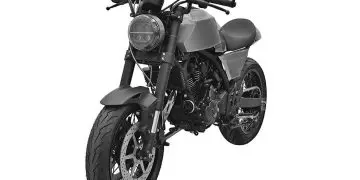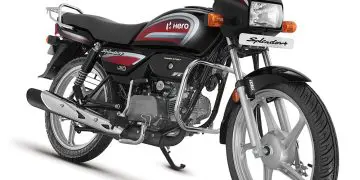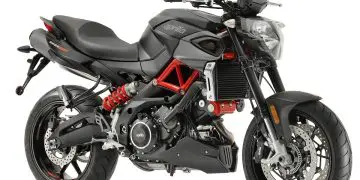The 4 inline cylinders of the new BMW M 1000 RR – similar, but not identical to those found in the S 1000 RR – seem to not behave exactly as we would expect from a so-called normal inline four-cylinder engine. The reason for this is the well-known variable valve opening system, or Shift Cam, that BMW has been implementing in its engines. The truth is that this system allows the M 1000 RR engine to be progressive throughout the rev range, offering good response at any speed, but it makes it a bit rough and with some unwanted vibrations, especially at constant speeds on the road. As soon as we start the bike, the heart of BMW seems like an angry lion ready to attack. Indeed, with 212 hp, we can only expect fierceness. However, we should not confuse fierceness with aggressiveness, as this engine is easy to tame, and with all the technological aids, including the “Shift Cam,” we can explore all the power relatively smoothly, knowing that from 9,000 rpm, the potential is fully unleashed. And as we mentioned earlier, the engine is quite responsive throughout the rev range, but only from roughly 8,000 rpm does it behave like a common inline four-cylinder engine, either due to the fantastic sound coming from the intake and the Akrapovic exhaust, or the cleaner behavior it exhibits. One thing is clear. This engine is designed and tuned – at least in this M 1000 RR – to run at high revs and be pushed to the limit. And we can say this even by the excessive heat it showed, even at speeds around 100/120 km/h.
TRACK SET
After realizing that the engine is clearly designed to deliver the best possible performance, we can see that the rest of the set is designed and projected for the circuit. Immediately looking at this M 1000 RR, we can see that the bike screams: track!! Details such as the huge front carbon wings, which produce 22.6 kg of downforce, a windshield optimized for maximum speed, carbon M rims to increase front wheel contact pressure with the asphalt, aerodynamic brake disc protections, are details that indicate that this bike was born totally focused on the circuit. Internally, this M 1000 RR also has changes compared to the S 1000 RR, with titanium valves, optimized camshafts and titanium connecting rods that reduce the weight of internal components by 340g. The suspensions are fully adjustable, but not electronic, indicating once again, total focus on the circuit, something we also understood by its excessive rigidity for road use, except on curved roads that require a more applied pace. There, we begin to understand the purpose of the rigidity of these suspensions, being certain that to make the whole set work to its full potential, a racetrack is the right place. And if we talk about fast rhythms, we have to talk about the M brakes, which have proven to be absolutely phenomenal, both in terms of touch and braking power. We understand that BMW’s partnership is with Nissin, in order to deliver a set of brakes with two 320 mm discs at the front and one 220 mm disc at the rear.THE BEST High-revving engine, stability of the package, braking TO IMPROVE Vibrations, heating
TECHNOLOGY THAT NEVER ENDS
We have already talked about non-electronic technology, such as the carbon front wings, carbon wheels, or aerodynamic protections for the front brake discs. And if in the S 1000 RR all the electronic arsenal was already a huge advantage for riding the bike, when we add components that were designed to increase performance, we have a bike in hand that not only becomes friendly to explore, but also becomes extremely effective in everything we do. Whether in acceleration or braking, the stability and predictability of this M 1000 RR make it very enjoyable to ride, especially at speeds more suited to the track than public roads. But it is important to go back to electronics, because without it, everything else would not have the same impact. As soon as we turn on the M 1000 RR we have a unique animation created for this bike that indicates that we are facing the base model of the World Superbike Championship.
The 6.5″ TFT display reveals excellent visibility and the usual information distribution on BMW panels. We have a total of 7 customizable riding modes, which offers an almost infinite array of customization of various parameters, such as power delivery, engine braking, or even ABS intervention, with the “base” mode of this bike being the “Race” mode.
The bike has its place, but it is certainly not on the road. Or it may even be on the road, but with the particularity of not being a particularly pleasant bike to ride on public roads, but it will have everything we need, and more, to drive us crazy with what is possible to do on two wheels, with a huge probability of, sooner or later, losing our driver’s license. The M 1000 RR was designed and conceived to be ridden on the track, and that is where we are sure it is its natural habitat.
BMW M 1000 RR
ENGINE 4-cylinder in-line, liquid-cooled
DISPLACEMENT 999 cc
POWER 156 kW (212 hp) @ 14,500 rpm
TORQUE 113 Nm @11,100 rpm
TRANSMISSION 6-speed
FRAME cast aluminum alloy, self-supporting engine
TANK 16.5 liters
FRONT SUSPENSION 45 mm inverted telescopic fork, fully adjustable, 120 mm travel
REAR SUSPENSION fully adjustable central monoshock, 118 mm travel
FRONT BRAKE dual 320 mm discs, 4-piston Nissin calipers
REAR BRAKE 220 mm disc
FRONT TIRE 120/70 ZR17
REAR TIRE 200/55 ZR17
WHEELBASE 1,457 mm
SEAT HEIGHT 832 mm
WEIGHT 193 kg
MRSP (from) €34,651
MRSP (tested unit) €40,479








